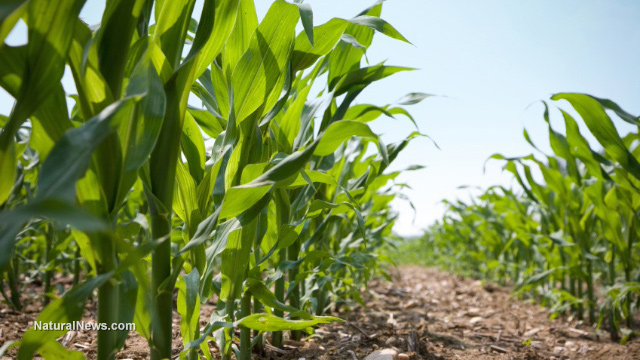J.Crow’s® Lugol’s Iodine
Free S&H.Restore lost reserves.J.CROW’S®Lugol’s Iodine Solut...
Turmeric Bowel Cleanse
Hulda Clark Cleanses
J.Crow’s® Lugol’s Iodine
Free S&H.Restore lost reserves.J.CROW’S®Lugol’s Iodine Solut...
Turmeric Bowel Cleanse
Hulda Clark Cleanses
Millions of bees turning up dead around GMO corn fields soaked with neonicotinoid pesticides

(NaturalNews) As the European Union considers whether to lift restrictions on three pesticides in the neonicotinoid family, it would do well to consider the phenomenon, known to Canadian beekeepers, in which bees start dying in droves shortly after corn planting season.
"Once the corn started to get planted our bees died by the millions," said beekeeper Dave Schuit in summer 2013, as reported by Eat Local Grown.
That spring, Schuit lost 600 hives containing 37 million bees. The same year, Canadian farmer Gary Kenny said that eight of the 10 beehives that he kept on his property died shortly after his neighbors planted corn in their fields.
Genetically modified (GM) corn is widely planted in Canada, but because the bee deaths occurred just after planting, the corn plants are not likely to blame for this particular die-off. Instead, beekeepers believe the cause is that the corn seeds were pre-treated with neonicotinoids. Air seeding causes neonicotinoid dust to fly off the seeds and into the air, drifting across the landscape.
Numerous studies point finger at neonics
In one study, researchers from American Purdue University examined the bees that died or were dying as part of the spring 2013 die-off. "Bees exhibited neurotoxic symptoms, analysis of dead bees revealed traces of [the neonicotinoids] thiamethoxam/clothianidin in each case," they wrote. "Seed treatments of field crops (primarily corn) are the only major source of these compounds."
A local Pest Management Regulatory Agency investigation also pointed to the same cause, concluding that corn seeds treated with those neonicotinoids "contributed to the majority of bee mortalities."
"The air seeders are the problem," said Paul Wettlaufer, a local farmer and director of the Ontario Federation of Agriculture.
Neonicotinoids are "systemic pesticides." They are applied to the seeds prior to planting, and then taken up into every tissue of the plant, including leaves, seeds, pollen, flowers and nectar. This makes them highly lethal not just to agricultural pests, but to all insects, and even birds that visit the plants for any reason.
"Large scale prophylaxic use [of neonicotinoids] in agriculture, their high persistence in soil and water, and their uptake by plants and translocation to flowers ... put pollinator services at risk," concluded one international research study.
Not only pollinators are threatened. Two major studies in 2015 found that the pesticides have widespread, dangerous effects on entire ecosystems. One, published in the journal Nature, found that neonicotinoid use was causing bird populations to crash. This is likely caused by both direct poisoning and by devastation of their invertebrate food sources.
Meanwhile, an analysis by the the Task Force on Systemic Pesticides, of 800 separate studies, concluded that even when used according to manufacturer guidelines, neonicotinoids wreak havoc on "non-target" species such as earthworms, insects, aquatic invertebrates and even lizards and fish. The pesticides are "likely to have a wide range of negative biological and ecological impacts," the task force wrote.
The growing case for a ban
In 2013, the European Food Safety Authority (EFSA) placed a two-year ban on the use of three neonicotinoids, citing a likely risk to bees. The EFSA has now launched a new study to review that policy, with results expected in January 2017.
Yet the evidence for a ban on neonicotinoids is even stronger now than it was two years ago. Even the U.S. Environmental Protection Agency (EPA) has been forced to admit that the chemicals devastate pollinators. The agency recently announced the findings of field trials, finding that even very low level use of neonicotinoids (25 parts per billion in plant pollen and nectar), caused measurable drops in populations of honeybee hives.
Researchers believe that neonicotinoids damage bee brains, specifically the ability to process information related to orientation and direction.
Sources for this article include:
EatLocalGrown.com
ThePost.ON.ca
CBan.ca
TheEpochTimes.com
NaturalNews.com
DigitalJournal.com
TheGuardian.com
Learn more: http://www.naturalnews.com/052710_honeybees_GMO_corn_neonicotinoids.html#ixzz3xvxHFKHp
This Forum message belongs to a larger discussion thread. See the complete thread below. You can reply to this message!
-
Millions of bees turning up dead around GMO corn f...
 R InCharge
8 y
1,025
R InCharge
8 y
1,025
This is the position of the above message within the thread.
CureZone Newsletter is distributed in partnership with https://www.netatlantic.com
Contact Us - Advertise - Stats
0.078 sec, (4)